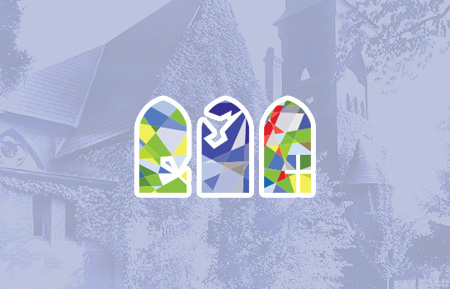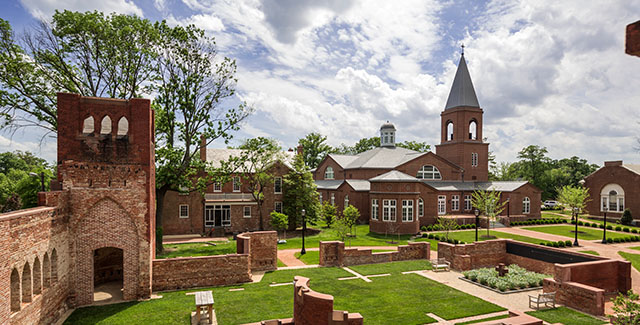The Virginia Theological Seminary story began in 1823
in the sacristy of St. Paul’s Episcopal Church in Alexandria, Virginia. Driven by the conviction that faithful and thoughtful education was the answer to the problems facing Anglicanism in America, our founders included Bishop William Meade, the third Bishop of Virginia, and Francis Scott Key, whose 1814 poem entitled “The Defence of Fort McHenry” became the text for our National Anthem in 1931.
The Seminary opened with two instructors and fourteen students.
-
![Virginia Theological Seminary placeholder image]()
1815
to 1864
William Boone,(1811–1864) missionary bishop to the Anglican diocese of Shanghai
-
![Virginia Theological Seminary placeholder image]()
1816
to 1874
John Payne, (1815–1874) missionary bishop to the Episcopal Church in Liberia
-
![Virginia Theological Seminary placeholder image]()
1823
The Rev. Reuel Keith, a graduate of Middlebury College, Andover Seminary, and a former rector of Bruton Parish Church, became the Seminary’s first elected professor in 1823.
-
![Virginia Theological Seminary placeholder image]()
1827
In 1827, land was provided for the construction of a permanent and dedicated Seminary campus, which prompted the move to our current location, on a hilltop two and a half miles west of the city of Alexandria. The original library building was completed in 1855 and St. George’s Hall in 1856.
-
![Virginia Theological Seminary placeholder image]()
1830
John Henry Hill, Class of 1830, was our first foreign missionary, serving in Greece. He and his wife Frances Maria Mulligen Hill are considered founders of the education system in Athens.
-
![Virginia Theological Seminary placeholder image]()
1855
Channing Moore Williams, Class of 1855, became a missionary and later a bishop in China and Japan. We share the fruits of his extraordinary ministry with Rikkyo University, which he founded.
-
![Virginia Theological Seminary placeholder image]()
1859
A generous gift from two New York brothers, John and William Henry Aspinwall, enabled the construction and dedication of the landmark Italianate, Gothic Revival, Aspinwall Hall in October of 1859. Aspinwall Hall and adjacent buildings of the period designed by Baltimore architect Norris Starkweather, are listed in the National Register of Historic Places. Enslaved labor, including slaves loaned from Mt. Vernon, helped construct Aspinwall Hall.
-
![Virginia Theological Seminary placeholder image]()
1862
to 1865
During the Civil War, from March 1862 to August 1865, students and faculty decamped to Virginia’s Shenandoah Valley, while the campus became a base for Union soldiers. Buildings became hospitals and tents were used to house some 1,700 wounded troops. The 500 soldiers who were buried on the campus grounds were later relocated to what would become Arlington National Cemetery.
-
![Virginia Theological Seminary placeholder image]()
1893
Beginning in 1835
Phillips Brooks (1835–1893), preacher, author, bishop of Massachusetts
20th Century
-
![Virginia Theological Seminary placeholder image]()
1900
While the first half of the 20th century saw steady growth for VTS, the shadow of segregation was dividing the country and the Church.
-
![Virginia Theological Seminary placeholder image]()
1916
Paul Abe, VTS Class of 1916. He is one of many foreign students who came from Japan and other countries to study at VTS.
-
![Virginia Theological Seminary placeholder image]()
1923
By 1923, the year of its Centennial, the Seminary had regained the resources, the certainty of full enrollment, and the invested funds that had characterized the institution in MISSING INFO 186?
-
![Virginia Theological Seminary placeholder image]()
1933
John Eldridge Hines graduated from VTS in 1933. When he was elected the 22nd Presiding Bishop of The Episcopal Church in 1965, at the age of 54, he was the youngest person to hold that office. With his retirement in 1974, it was said that he had been a prophet in his own time as he made his ministry about the Civil Rights movement, liturgical renewal, the ecumenical movement and the promotion of African Americans and women in church councils.
-
![Virginia Theological Seminary placeholder image]()
1950
VTS built the Bishop Payne Library, named after the Divinity School. The collection numbers over 225,000 volumes of books and bound periodicals and 190,000 e-books. Specialist areas of focus include biblical studies, church history, theology, the Protestant Reformation, missions, liturgies and church music. In partnership with the Historical Society of the Episcopal Church, the Bishop Payne Library also hosts the African American Episcopal Historical Collection (AAEHC), documenting the history of the African-American Episcopalians in the United States.
-
![Virginia Theological Seminary placeholder image]()
1951
The Board of Trustees admitted the first African American student, John T. Walker. GRADUATING CLASS? From 1977 to 1989, he was the Bishop of Washington, the first African American Bishop of that Diocese. He also served simultaneously as Dean of the Washington National Cathedral.
-
![Virginia Theological Seminary placeholder image]()
1953
June 3rd
The Seminary merged with the Bishop Payne Divinity School, a distinguished theological school for African Americans.
-
![Virginia Theological Seminary placeholder image]()
1954
Beginning in 1885
Lindel Tsen (1885–1954) finishes term as first and only Chinese Presiding Bishop of the Chung Hua Sheng Kung Hui
-
![Virginia Theological Seminary placeholder image]()
1956
Since 1950, 27 new buildings have been added to the 88-acre campus, including 15 faculty homes, five dormitories, four student apartment buildings, Coffield Refectory and Scott Lounge, and the Addison Academic Center.
-
![Virginia Theological Seminary placeholder image]()
1969
The Rev. Alison Cheek became one of the first two women admitted to the Master of Divinity program at VTS. She graduated in 1969 and later walked into the history books as one of the Philadelphia Eleven, the first women to be ordained to the priesthood in the Episcopal Church.
Late 20th Century – Early 21st Century
-
![Virginia Theological Seminary placeholder image]()
1994
Term ending in 2007
The Very Rev. Martha J. Horne became the first female Dean & President at VTS in 1994, and led the Seminary from 1994 to 2007. The defining moment of her deanship may well have been the historically significant Holy Life Policy.
Holy Life Policy
-
![markham staff headshot photo]()
2007
August 1st
The very Rev. Ian S. Markham, Ph.D., became Dean and President.
-
![Historical Photo Virginia Theological Seminary Aspinwall Hall]()
2010
October 20th
The 124-year-old Immanuel Chapel burned to the ground. The ruins were later converted into an outdoor Chapel Garden. The west side of the garden features a dedicated area for the ashes of the faithful. In the center stands a stone cross which was part of the west wall of the 1881 Chapel.
-
![campus during golden hour]()
2015
October 13th
A new Immanuel Chapel, designed by Robert AM Stern architects, was consecrated and dedicated to the Glory of God by the Archbishop of Canterbury. World-famous stained glass designer Brian Clarke was commissioned to create windows for the Chapel.
-
![Visit Campus]()
2017
October
The Very Rev. Ian S. Markham presided over the dedication of St. Cyprian’s Labyrinth, which honors the St. Cyprian’s Chapel, or The Church of the Good Shepherd, that was built at the Seminary in the 1800s to serve the local African American community after the Civil War.
-
![Virginia Theological Seminary placeholder image]()
2018
February
The Clarke stained glass windows in Immanuel Chapel were dedicated by presiding bishop, the Most Rev. Michael B. Curry.
-
![Historical Photo Virginia Theological Seminary]()
2019
September
VTS announced the creation of a $1.7 million reparations fund to allocate money specifically for the descendants of the enslaved who worked on the campus, as well as for Black seminarians and Black worshipers who experienced discrimination.







